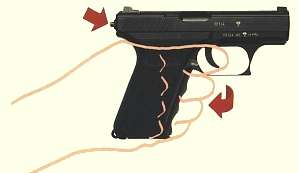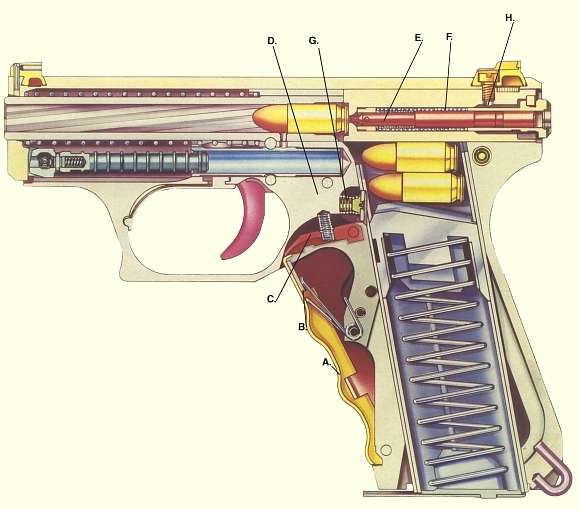



| A The P7 pistol automatically assumes the "safe" mode until the moment the gun is ready to fire. |  |
| B. Gentle but firm pressure is applied to the cocking lever (a) and a pin indicator (B) extends outward denoting that the gun is ready to be fired. |  |
| C. When the trigger is pulled, the gun will fire. Once cocked, the pressure on the cocking lever can be reduced, allowing a swift smooth trigger pull emptying the magazine as fast as the trigger is pulled. |  |
| D. Releasing the pressure on the cocking lever returns the P7 to the "safe" mode. |  |
The "CONTINUOUS MOTION PRINCIPLE"
is a result of years, dedicated to research and redesigning, to produce
and uncomplicated, yet rapid firing pistol action that works with space-age
precision.
The firing sequence of the P7 is simple: When cocking lever (A) is depressed; drag lever (B) is pressed back. Cocking latch (C) is engaged and holds drag lever (B) in place.
Transmission lever (C) is moved back at the same time as drag lever (B) and tensions firing pin (E) via compression spring (F)
When the trigger is pulled, the transmission (G) pivots sear lever (D) clear of cocking pawl on the firing pin (E) and at the same time, pulls down drop safety catch (H)
Under the action of spring (F), firing pin (E) accelerated forward and strikes primer cap in cartridge.Compression spring (F) returns firing pin to its rest position.
8 major components are involved in the firing process of the HK P7 pistol. An action like this so simple, it's revolutionary!